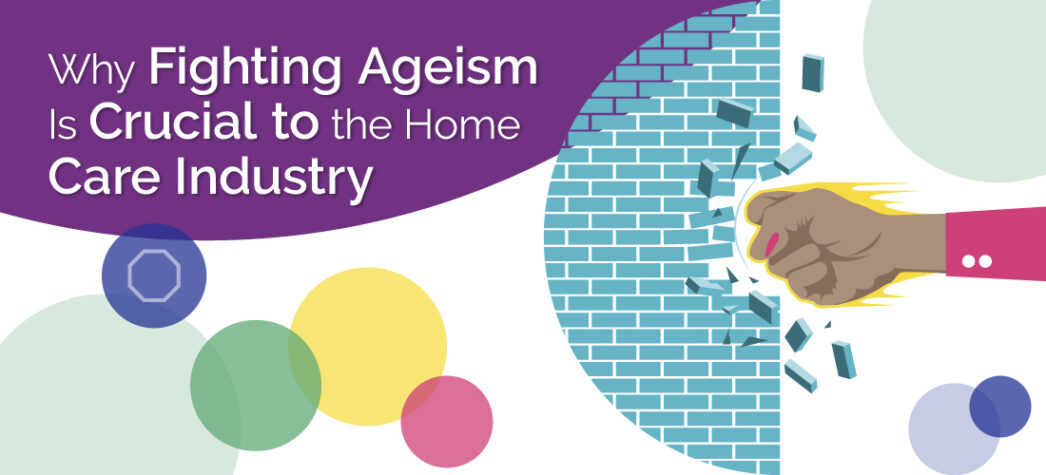
You may not know it by name, but you’ve certainly seen it in action. Ageism, though perhaps innocuous or even endearing at first glance, is incredibly harmful. Consider how it feels from the perspective of an older adult in the following examples:
- A provider addresses health questions about an older adult to the family rather than to the individual directly.
- A caregiver completes activities of daily living for an individual who is still quite capable of performing these tasks independently.
- A nurse refers to older adults as “honey,” “sweetie,” “young lady,” and other demeaning, patronizing terms.
An astounding 82% of older Americans shared in a recent survey that they regularly experience ageism.
Let’s dig deeper into exactly what ageism is and why fighting ageism is so important for all of us—in the care industry and our society.
What Is Ageism?
At the most basic level, ageism is a specific way of thinking, acting, and discriminating towards others (or even yourself) based on age. It is one of the last prejudices our society still sanctions. Like racism, sexism, and other “isms,” ageism is a harmful stereotype that places limitations on people without regard for their capabilities or who they are as an individual. Ageism sees someone as “other,” rather than realizing the similarities we all share in being part of the aging continuum.
There are three main categories of ageism:
- Interpersonal ageism (in social situations)
- Internalized ageism (against yourself)
- Institutional ageism (policies within a business)
As a home care provider, you’re uniquely positioned to promote or combat ageism daily. Left unchecked and untrained, your staff may, even with the best of intentions, fall into these common ageist practices:
- Infantilizing. This involves using a singsong tone of voice, oversimplifying language, or speaking to an adult as a child (also known as “elderspeak.”) It creates a dynamic of inequality between caregivers and the adults in their care.
- Making assumptions. A person may be deemed unable to tackle tasks independently when, in reality, all that’s needed is some extra time, patience, and perhaps modifications in how a task is performed.
- Promoting possessiveness. Using terms when communicating with family members like “your loved one” is common but implies that an older adult belongs to them. This is especially belittling when the older person is in the room and should be addressed directly.
How to Break Free From Ageism
There are some specific action steps you can take to ensure the clients you serve are treated with the respect they deserve. For instance:
- Train your staff—and yourself. Make education about ageism part of onboarding new staff and a regular refresher for existing staff. This should include caregivers and all staff members who have contact with clients and their families.
- Make it personal. Ideally, the care you provide is personalized to the individual, which means getting to know them as a person, and not just the challenges they’re facing. Creating conversations and activities around the person’s interests shows respect for their individuality and the desire to develop meaningful connections.
- Promote independence. This should always be a top priority that everyone on your caregiving team understands. Instead of tying a person’s shoes so they can get to their doctor’s appointment on time, allow extra time and help only when asked or necessary. Include the older adult in decision-making throughout the day, empowering them to remain in control of every possible facet of their life.
- Review hiring practices. Ensure your HR staff understands that age should never be a barrier or even a consideration in hiring. Your team should embrace diversity in all of its forms, including age.
- Check your marketing materials. Review your website content, brochures, flyers, ads, brand, etc. to see if you’re unwittingly including ageist messages. Are you referring to your target audience as “seniors,” “the elderly,” “elders,” or “older adults?” Is there an opportunity to change some of your verbiage to simply “individuals” or “people?” Make sure that how you describe and portray your company and clients exemplifies your commitment to the respect and empowerment you provide to those you serve.
- Images matter, too. Take a look at the images on your marketing materials. Are they stereotypical, such as hunched, gray-haired ladies in buns? Do they focus on a disability, such as older adults in wheelchairs, using walkers, or being fed? Your clients and potential clients see themselves as younger. Their adult children may as well. Choose images that show how the older adult will FEEL when using your services. Make sure you’re considering diversity in your images as well.
Let’s Work Together to Overcome Ageism!
At corecubed, we’re deeply passionate about changing the face of aging. Our care marketing and sales experts have decades of experience partnering with care companies to create messages and materials that resonate with older adults and the families who care about them.
Contact us at 800.370.6580 to learn how to stand together against ageism in our society and promote an environment that fosters respect and self-esteem.

